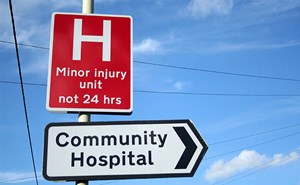Over the last couple of weeks, the Centers for Medicare & Medicaid Services (CMS) has released two regulations that update policies and payment parameters for private health plans: one impacting health plans that operate in Medicare Advantage and the Medicare Prescription Drug Program (Medicare Part D) and one affecting health plans that operate in the Federal Exchange (the marketplace established by the Affordable Care Act). These are annual proposed regs that, when finalized, would affect health plan policies and payments in 2023. ACEP reviews and comments on these regs each year, as they include policies that impact you as emergency physicians and the patients you serve.
One major issue that ACEP monitors and has previously commented on is the network adequacy requirements that CMS establishes for Medicare Advantage and Affordable Care Act (ACA) Exchange plans. As background, in order to operate under the Medicare Advantage program, health plans must ensure that 85 to 90 percent of their enrollees have “access” to at least one in-network provider/facility in a defined list of specialty types (emergency medicine is NOT included in this list). Access is determined through a set of “time and distance” standards that vary provider type-by-provider type and county-by-county, depending primarily on whether the county is located in an urban or rural area. For example, health plans under Medicare Advantage are required to ensure that 90 percent of their enrollees in urban areas have access to an in-network primary care provider within 5 miles and a 10-minute drive and that 85 percent of their enrollees in rural areas have access to an in-network primary care provider within 30 miles and a 40-minute drive.
Medicare Advantage health plans can also receive a 10-point credit from the time and distance standards for certain provider-types (i.e., an 80 percent threshold in urban areas rather than a 90 percent threshold) if the providers offer additional telehealth services to patients that aren’t covered by traditional Medicare. Finally, there are requirements around the minimum number of providers that must be in-network per 1,000 Medicare beneficiaries.
In 2020, CMS issued a reg that codified many of its existing Medicare Advantage network adequacy requirements—including formalizing the list of specialty types that are included in the time and distance standards. When that 2020 reg was first proposed, ACEP specifically requested that emergency medicine be added to the list. We stated that we believe that it is essential for all beneficiaries enrolled in Medicare Advantage to know from their Medicare Advantage health plan in advance of an emergency if the emergency physician treating them is in-network (NOT during or after an emergency has occurred). The very nature of emergency department (ED) care, more than any other type of specialty care, precludes the opportunity for patients to preferentially go to facilities with in-network emergency physicians. While we made a compelling argument, CMS did not adopt our recommendation to add emergency medicine as a specialty type in its Medicare Advantage network adequacy requirements.
Flash forward to the regs released last week. CMS includes proposed changes to network adequacy requirements for both Medicare Advantage and ACA Exchange plans—although the changes to the ACA Exchange Plans definitely will have a bigger impact on you as an emergency physician.
The network adequacy requirements for ACA Exchange plans aren’t as well defined as the Medicare Advantage requirements are— but like Medicare Advantage, the current list of specialty types included in the time and distance standards does not include emergency medicine. In the ACA Exchange reg, CMS is proposing to include emergency physicians in its network adequacy requirements! CMS states in the reg that it is proposing this policy to “provide proactive consumer protections, and, similar to the No Surprises Act[…] to increase enrollee access to in-network providers.”
ACEP definitely agrees with this proposal, given that it is the exact same policy that we requested for Medicare Advantage. However, we don’t think the No Surprises Act incentivizes in-network contracting—in fact the exact opposite. As discussed in previous Regs & Eggs blogs, the flawed independent dispute resolution (IDR) policy that the federal government finalized will result in even narrower networks since health plans will have little incentive to fairly negotiate with emergency physician groups and keep them in-network. We hope that by including emergency physicians in the network adequacy requirements, private health plans may have more of an incentive to negotiate with emergency physician groups, since they will be required to ensure that their enrollees have access to at least some in-network emergency physicians.
While we are optimistic that this proposal will be helpful and potentially lead to more good-faith contract negotiations between private health plans and emergency physician groups, there are a few caveats and unknown factors that may ultimately influence how effective this policy will be:
- First, as stated above, the ACA Exchange plans’ network adequacy requirements aren’t as fleshed out as the Medicare Advantage requirements. In the ACA Exchange reg, CMS proposes to align the time and distance standards for Federal Exchange plans with the established Medicare Advantage standards. However, CMS is seeking comment on the specific parameters for time and distance standards and could ultimately decide to make them looser than the Medicare Advantage standards. In our comments on the reg, ACEP will certainly encourage CMS to finalize appropriate time and distance standards that ensures reasonable access to board-certified emergency physicians no matter where the enrollee lives—in both urban and rural areas.
- Enforcement of network adequacy standards has always been an issue, and for the last several years, CMS has delegated that responsibility to states. In the ACA Exchange reg, CMS is proposing to take back the responsibility of evaluating the adequacy of provider networks for plans in the Federal Exchange starting in 2023. However, some states that have the capacity to conduct these reviews can still choose to do so. Without strict enforcement of network adequacy standards, the standards themselves are essentially meaningless—and it remains to be seen how aggressively the federal government will enforce the standards once it has that responsibility.
- There seems to be some apprehension from CMS about implementing strict network adequacy requirements. CMS includes a request for comments in the ACA Exchange reg on whether physicians or hospitals would be able to leverage the stricter requirements to negotiate higher payments from health plans, thereby driving up health care costs and hurting consumers. In other words, CMS is worried that because a certain number of physicians/hospitals need to be in-network in order for the health plan to meet the network adequacy requirements, that physician groups/hospitals will take advantage of that requirement and charge higher prices. In my opinion, just seeking comment on this issue shows that CMS still has the same level of bias against providers that it did when it drafted the No Surprises Act CMS assumes that providers will act in bad faith and try to exploit the network adequacy requirements to make more money—hence the agency seeking comment on how to potentially avoid that scenario. ACEP plans to strongly refute that implied assertion in our comments and state that strong network adequacy requirements are needed to ensure that health plans play by the rules and don’t unilaterally decide to kick providers out-of-network (which is already happening because of the new No Surprises Act regulations).
- The proposed network adequacy requirements only apply to ACA Exchange plans that operate on the Federal Exchange. As of 2022, there are 21 State Exchanges—and State Exchanges have a mix of network adequacy policies in place. ACEP encourages states to adopt a comprehensive set of network adequacy requirements.
As you may have noticed, most of the changes I have discussed are found in the ACA Exchange reg. There were some more minor changes to Medicare Advantage network adequacy requirements in the Medicare Advantage and Medicare Part D reg. Unfortunately, CMS did not propose to include emergency physicians in the Medicare Advantage network adequacy requirements, but the agency did propose to strengthen oversight of its standards by requiring that health plan applicants demonstrate that they have a sufficient network of contracted providers to care for beneficiaries before CMS will approve an application for a new or expanded Medicare Advantage plan.
Comments on both the Medicare Advantage/Part D reg and the ACA Exchange reg are due in the coming weeks, and ACEP is currently working on drafting responses. Stay tuned for more details on ACEP’s responses, as well as a summary of the final policies that CMS ultimately chooses to adopt.
Until next week, this is Jeffrey saying, enjoy reading regs with your eggs.






